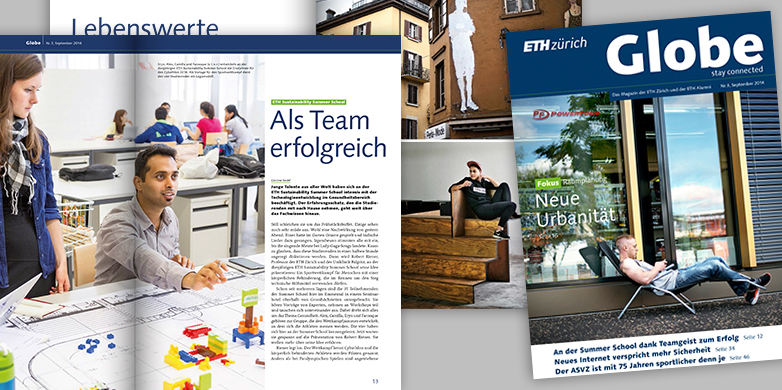Globe: new urban models
As Switzerland grows, the demand for housing and work space is also on the increase. But what actually makes an urban area worth living in, and how can we meet these needs without destroying precious countryside? In the latest issue of Globe, the magazine of ETH Zurich and ETH Alumni, researchers from ETH Zurich discuss their approaches to solving the problem.
High rises, terraced houses, replacement buildings: structures are sprouting up left, right and centre in Switzerland. One thing is clear: the rural idyll that many associate with Switzerland is long gone. Compared to many other countries, however, it still offers a high quality of life. The challenge for planners and architects is to maintain this quality despite the building boom and urbanisation. But what really makes an area worth living in, and how should we structure planning processes in order to end up with structures that meet these criteria? As part of National Research Programme 65 “New Urban Quality”, researchers from ETH Zurich set out in search of some answers. And researchers chose their case studies from large cities and small communities alike, whether in the trendy urban neighbourhood of Zurich West or in agglomerations and rural areas. And the researchers are convinced that some of their results do not merely apply to Switzerland, but can provide insight for countries around the globe.
Over the summer, students from 17 nations flocked to ETH Zurich for the ETH Sustainability Summer School, where they got to grips with technology development in the healthcare sector. The Globe report reveals just how much effort and dedication the young scientists channelled into developing their ideas.
The portrait of ETH Zurich alumnus Patrick Anquetil tells the story of someone who studied at ETH Zurich before heading out into the world to found companies. Having settled on the US East Coast, he is currently forming his second start-up: Portal Instruments, a company that aims to market a device that enables users to inject medication without needles.
And finally, the “Anno” section gets sporty. Be it morning exercises, segregated workouts for men and women, or the question of whether yoga is really a sport, the 75-year history of the Academic Sports Association Zurich (ASVZ) has no shortage of anecdotes – and an even more impressive success story.
Get «Globe»
The magazine of ETH Zurich and ETH Alumni is available as an annual subscription (four issues for CHF 40; order via globe@hk.ethz.ch). You can also download Globe for free as a PDF for iPad and Android. Or read the magazine online in Englishor German.

Comments
No comments yet